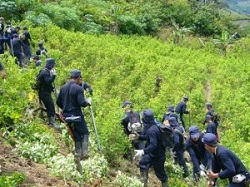Peru’s government will once again implement a militarized security strategy for the coca-producing VRAEM region, a policy which could lead to increased confrontations between authorities and the Shining Path guerrilla group.
Ministerial Council President Fernando Zavala announced on October 5 that the government would declare a 60-day state of emergency in several districts of the Apurimac, Ene and Mantaro River Valleys (VRAEM), starting October 11, reported El Comercio. Authorities said this would allow for the renewed deployment of soldiers in the area, with the objective of combatting what Defense Minister Mariano González called “narcoterrorism.”
The VRAEM region had been under a state of emergency for more than three decades until last year, when that measure was lifted in certain areas following the capture of several leaders of the Shining Path.
The officials also stated that the military would now take the lead in the fight against drug trafficking in the region, with a general being appointed at the head of the VRAEM Special Command and a vice admiral leading intelligence operations. While the operations will be under military authority, the police will also be integrated in the process.
Carlos Tubino, the vice president of the Congressional Defense Committee, told the Andina news service that while the army currently has 64 military bases in the VRAEM region, it does not have the mandate to arrest drug traffickers or decommission drugs. The state of emergency will provide the legal basis for a renewed military involvement in the area, following the previous administration’s decision to demilitarize the anti-drug fight in the VRAEM.
InSight Crime Analysis
The decision to remilitarize the fight against drug trafficking in the VRAEM could bring security forces into more frequent confrontation with the Shining Path. The VRAEM is Peru’s main coca cultivation area and is also a stronghold of the guerrilla group, which has become increasingly involved in drug trafficking over the years, moving from simple taxation of the product transported through its territory to direct participation in the cocaine trade. Attempts to disrupt the Shining Path’s drug trade-related activities with heavy-handed military operations are likely to be met with fierce resistance, a dynamic which Peru has previously witnessed in recent years.
SEE ALSO: Coverage of the Shining Path
Increasing the military’s involvement in fighting drug trafficking in the VRAEM could produce short-term results. For example, a previous campaign managed to push the Shining Path out of the Alto Huallaga region, and coca cultivation in the area fell by nearly 65 percent in a year. However, militarization is rarely a viable long-term strategy for combatting the drug trade, as evidenced by the decades of military campaigns against the Shining Path that have failed to wipe out the guerrilla group or to prevent their continued involvement in drug trafficking.

